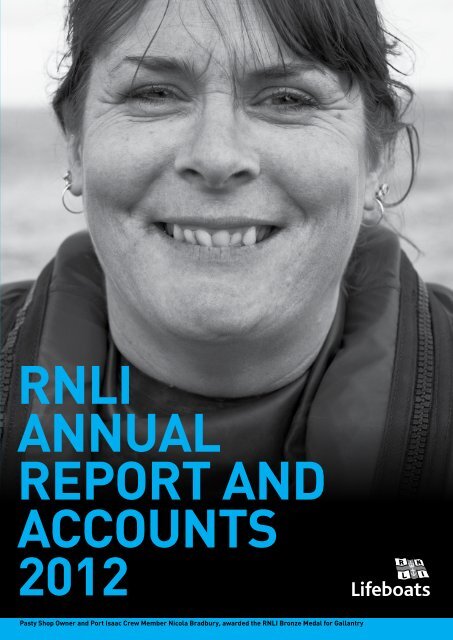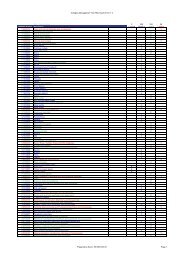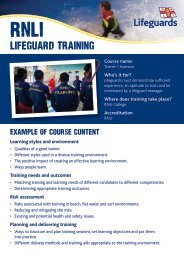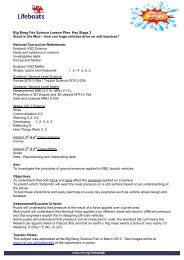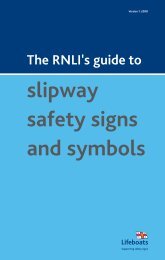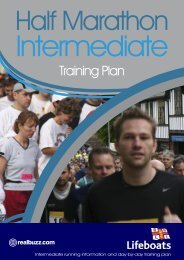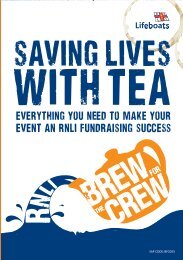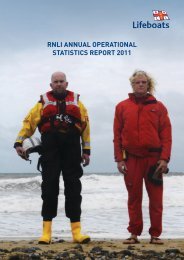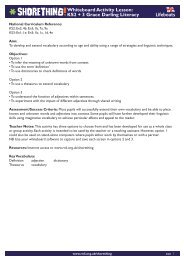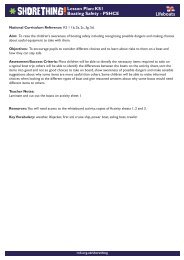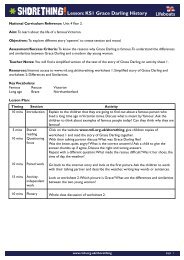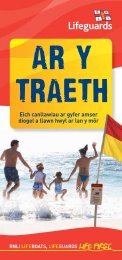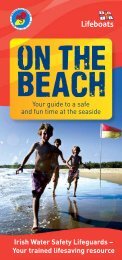You also want an ePaper? Increase the reach of your titles
YUMPU automatically turns print PDFs into web optimized ePapers that Google loves.
Photo: <strong>RNLI</strong>/<strong>Mike</strong> Lavis
Annual Report of the Trustees of theRoyal National Lifeboat InstitutionFOR THE YEAR ENDED 31 DECEMBER 2012Message from the ChairmanAs the charity that saves lives at sea, operating a rescue operation over more than19,000 miles of coastline, there continues to be a huge demand for our services.That is reflected in our operational statistics. Despite 2012’s miserable weather– which discouraged recreational boating – our lifeboat crews launched 8,346 timesand rescued 7,964 people. During the course of the year we passed a remarkablemilestone: 140,000 lives saved since the <strong>RNLI</strong> was formed 189 years ago. Theextraordinarily wet weather also saw our flood rescue teams being deployed 8 times– the highest number since we became involved in this type of operation.Meanwhile our lifeguards, operating on over 180 beaches, responded to 14,523incidents and assisted 16,418 people. Prevention is a key part of the lifeguards’ role,and the <strong>RNLI</strong> continued its coastal safety focus in 2012 delivering safety messages toover 250,000 people and reaching many more through the media.As you will read on page 14, total income was better than expected in 2012– especially given the continuing difficult economic environment. Thanks to theextraordinary efforts of our volunteer fundraisers and staff, fundraised voluntaryincome remained constant at £51.9M, and the <strong>RNLI</strong> also received several generouslegacies. At a time of such economic uncertainty, our supporters showedoutstanding generosity.Expenditure was once again down as our continuous improvement programmereduced costs and increased efficiency. For example, carrying out more legal workusing in-house expertise in contract management saved £43,000. Total charitableexpenditure was £116.2M while our contribution to our reserves was £34.1M.However, we spent £35.5M on our capital expenditure programme in 2012, fundingthe construction of new lifeboats, lifeboat stations and other assets that will help tosave lives for years to come.To continue to develop those lifesaving assets, and meet the cost of runningour year-round, 24/7 lifesaving service, we depend on our extraordinary volunteers,fundraisers and supporters. So, on behalf of the <strong>RNLI</strong>’s Trustees, I would like to thankall those who give their time and support to help keep everyone safer at sea.Admiral the Lord Boyce KG GCB OBE DLChairmanRoyal National Lifeboat Institution10 April 2013The Annual Report and Financial Statements of the Royal National Lifeboat Institution (<strong>RNLI</strong>) forthe year ended 31 December 2012 have been prepared in accordance with applicable accountingstandards, the Charities Act 2011, and the Statement of Recommended Practice (SORP) ‘Accountingand Reporting by Charities’ (revised 2005) (second edition 2008) and comply with the charity’strust deed.In 2011, the <strong>RNLI</strong>’s priorities for the 5 years from 1 January 2012 were published in the<strong>RNLI</strong> Plan 2012–2016. Extracts from the Plan, together with key achievements and performanceduring 2012, are included within this report. The full version of this plan is available from the <strong>RNLI</strong>’sregistered office or may be downloaded from the website at <strong>RNLI</strong>.org.1
Message from the Chief executiveThanks to the extraordinary spirit of the <strong>RNLI</strong>’s people, 2012 has proved to be a year ofstrong achievement across the <strong>RNLI</strong> despite challenging weather conditions around thecoast and an enduringly difficult economic environment on both sides of the Irish Sea.These achievements span every part of the charity’s activities: from the manycourageous rescues at sea and the unprecedented number of flood rescue operations, tothe irrepressible energy of our fundraisers and the remarkable work of our volunteers andstaff in transforming the <strong>RNLI</strong>’s support operations.None of this would have been possible without the extraordinary generosity of ourdonors and supporters, the spontaneous courage of our lifeboat crews and lifeguards, thededication of our fundraising branches and guilds, and the vision and determination ofthe <strong>RNLI</strong>’s hardworking staff.Looking to the next 12 months, the first Shannon class all-weather lifeboat will enterservice at Dungeness towards the end of 2013, and the All-weather Lifeboat Centre willshortly start rising from the depot site at our Poole Headquarters. Once fully operational,this facility will build, fit out, refit and repair our all-weather lifeboats, saving the <strong>RNLI</strong>over £3.5M every year in lifeboat construction and repair costs. 2013 will also see therollout of lifeguards to a further 20 beaches around the UK, and a growing emphasis oncoastal safety and our international lifesaving activities.We have no intention of slowing down the <strong>RNLI</strong>’s continuous improvementprogramme over the coming years. I confidently expect that, towards the end of 2013,we will have put in place the mechanisms to achieve £20M of annually recurring savings,despite the consistent growth in demand for our services. This money will be redirectedinto lifesaving operations, making the existing services more robust and helping todevelop new ways of saving lives at sea.I have no doubt that 2013 will be every bit as challenging as 2012. But we are doingeverything possible to equip the <strong>RNLI</strong> to adapt and grow in an unpredictable, rapidlychanging world – without losing our values and the special feel of this great institution.We are introducing more flexible working processes; we are working hard to make the<strong>RNLI</strong> more resilient in the face of unexpected events; and we are absolutely committedto getting the most out of every penny that our donors give us.Thank you all for your continued support.Paul BoissierChief Executive<strong>RNLI</strong>2
3Photo: <strong>RNLI</strong>/Max Wilcox
ABOUT THE <strong>RNLI</strong>FOR THE YEAR ENDED 31 DECEMBER 2012<strong>RNLI</strong> PURPOSEThe <strong>RNLI</strong> saves lives at sea.<strong>RNLI</strong> VISIONTo end preventable loss of life at sea.<strong>RNLI</strong> VALUESOur work is based on and driven by our values.Our volunteers and staff strive for excellence and are…Selfless: willing to put the requirements of others before ourown and the needs of the team before the individual, able to seethe bigger picture and act in the best interests of the <strong>RNLI</strong>, andto be inclusive and respectful of others. Prepared to share ourexpertise with organisations that share our aims.Dependable: always available, committed to doing our part insaving lives with professionalism and expertise, continuouslydeveloping and improving. Working in and for the communityand delivering on our promises.Trustworthy: responsible, accountable and efficient in the use ofthe donations entrusted to us by our supporters, managing ouraffairs with transparency, integrity and impartiality.Courageous: prepared to achieve our aims in changing andchallenging environments. We are innovative, adaptable anddetermined in our mission to save more lives at sea.THINGS WE WILL NOT CHANGEVolunteer EthosOur lifesaving service is provided wherever possible byvolunteers, generously supported by voluntary donationsand legacies.Independent of GovernmentWe do not seek funding from central Government.Major charity, community basedWe operate through local teams, centrally directedand resourced.MaritimeOur exceptional expertise is in the preservation of life at seaand on the water through prevention and rescue, togetherwith the delivery of coordinated safety, research andeducation programmes.HeritageWe are proud of our history and tradition and of the <strong>RNLI</strong>’sachievement of saving lives over nearly 2 centuries.HOW WE FULFIL OUR PURPOSEThe <strong>RNLI</strong>, through our Concept of Operations, saves lives at seathroughout the United Kingdom (UK), Republic of Ireland (RoI),Isle of Man (IoM) and Channel Islands (CI) by providing:• a strategically located fleet of all-weather lifeboats, which areavailable at all times, and tactically placed inshore craft, whichare subject to weather limitations• a lifeguard service on a seasonal basis• safety education and accident prevention• a flood rescue capability available for nationwide orinternational deploymentto a defined standard of performance, commensurate with theresources available, using trained and competent people who,wherever possible, are volunteers.STRATEGIC PERFORMANCE STANDARDSWe aim to:Achieve an average launch time of 10 minutes from notificationto the <strong>RNLI</strong>.> > An overall average launch time of 10 minutes was achievedin 2012 (2011: 10.3 minutes). This is reflective of previousyears where there have been only minor variances aroundthe 10-minute average.Reach all notified casualties where a risk to life exists, in allweathers, out to a maximum of 100 nautical miles.> > Lifeboats launched on service 8,346 times in 2012(2011: 8,905), rescuing 7,964 people (2011: 7,976), and saving328 lives (2011: 354).Reach at least 90% of all casualties within 10 nautical milesof the coast within 30 minutes of launch in all weathers.> > The performance standard achieved in 2012 was 92.1%(2011: 92.9%).Reach any beach casualty up to 300m from shore, within theflags, on <strong>RNLI</strong> lifeguard-patrolled beaches, within 3½ minutes.> > In 2012, <strong>RNLI</strong> lifeguards attended 14,523 incidents on<strong>RNLI</strong>-patrolled beaches (2011: 15,625), aided 16,418 people(2011: 17,654) and saved 115 lives (2011: 84). It is not costeffective to measure the average response time but ourrisk assessment process, fitness standards and operationalconfiguration of the lifeguard service are all designed toachieve this strategic performance standard.Deliver clear, straightforward safety advice that positivelyinfluences behaviour, measured against agreed benchmarks.> > In 2012, the coastal safety teams and beach lifeguardsdelivered a comprehensive programme of safety educationand prevention initiatives. These included sea safetyroadshows, lifejacket clinics, and safety onboard checks onprivate leisurecraft. The lifeguards delivered beach safetyprogrammes principally aimed at increasing children’sawareness of the hazards that can be encountered in4
the waters around our coastline. We have continued ourcampaign to encourage the wearing of lifejackets whenafloat with key messages being delivered through multiplemedia channels.Maintain the capability to deploy up to 16 Type B floodrescue teams:a. the first 2 teams to reach any rendezvous point within theUK, RoI and IoM within 6 hours of requestb. an international team of 6 boats and 25 personnel to anyUK port of departure within 24 hours.> > Flood rescue teams were deployed nationally on 8 occasionsin 2012, principally in response to floods in the south west ofEngland and Wales. One of these deployments to Umberleighin Devon resulted in the first award of the <strong>RNLI</strong>’s BronzeMedal for Gallantry to flood rescue team members whosaved the life of a woman who had been swept from her carinto a nearby river.PRINCIPAL ACTIVITIESThe <strong>RNLI</strong> saves lives at sea throughout the UK, RoI, IoM and CIthrough four principal activities – lifeboats, lifeguards, coastalsafety and education. It also operates a flood rescue team,available for national and international deployment. These fourstrands make up the <strong>RNLI</strong>’s Concept of Operations, which isunderpinned by extensive fundraising activity.The charity is founded on volunteers, who make up 95% ofthe <strong>RNLI</strong> team, including 4,600 volunteer crew members, 3,000volunteer shore crew and lifeboat station management, anddedicated supporters who raise funds, give safety advice and helpin our shops, museums and offices. They are supported by a coreof staff at <strong>RNLI</strong> Headquarters in Poole and at locations aroundthe UK and RoI.The <strong>RNLI</strong> was set up in 1824 to provide a lifeboat service andcurrently operates 346 lifeboats and other craft at 236 lifeboatstations, including four on the River Thames and four inlandstations at Lough Derg, Lough Ree, Enniskillen, and Loch Ness.The <strong>RNLI</strong> covers more than 19,000 miles of coastline andcontinually reviews its operations, opening or closing lifeboatPhoto: <strong>RNLI</strong>/Nigel Millard5
7Photo: <strong>RNLI</strong>/JP Trenque
Lifeguard servicePriorities 2012–16Expansion of the lifeguard service in accordance with therollout programme> > In 2012, lifeguard services were delivered from 183 lifeguardunits on beaches and our lifeguards dealt with 14,523incidents (2011: 15,625) assisting 16,418 people (2011:17,671) and saving 115 lives (2011: 84).Coastal Safety servicePriorities 2012–16Deliver cost-effective, coordinated coastal safety activities> > Throughout the year the Coastal Safety teams and beachlifeguards delivered a comprehensive programme of safetyinitiatives including roadshows, sea safety checks and beachsafety programmes principally aimed at increasing children’sawareness of the hazards that can be encountered in thewaters around our coastline.Further develop the management information used to drivefuture activities> > As part of the drive to continually improve our services,the approach to the delivery of Coastal Safety activitieswas reviewed. The outcome of this review will be a revisedstrategy to be delivered in 2013. A key part of this strategyis to gain a better insight into safety attitudes of identified‘at-risk’ groups so that safety initiatives are effective. TheOperations Research Unit is coordinating a number ofresearch programmes aimed at identifying and quantifyingrisk among marine users in order to ensure that safetyprogrammes are appropriately targeted and underpinned by aclear evidence base.Continue to influence safety standards in the beach andmarine environment> > In partnership with the RYA and MCA we continue topromote and encourage the wearing of lifejackets whenafloat, with key messages underpinning this initiative beingdelivered through multiple media channels.Capital lifeboat and shore facility deliveryTamar class – lifeboatTamar class – shoreworksShannon class – lifeboatShannon class – launching equipmentShannon class – shoreworksB class – lifeboatB class – shoreworksD class – boatHovercraftInshore rescue boatTraining boats2012 2013 2014 2015 20162–3 per annum1–2 per annum4–6 per annum2–4 per annum2–4 per annum8 per annum1–3 per annum7–14 per annum3 over 5 years5 per annum2 over 5 yearsPhoto: <strong>RNLI</strong>/Nigel Millard10
BOATS, EQUIPMENT AND ESTATE MANAGEMENTBoats and equipmentThe design, supply and support of affordable operationalplant and equipmentPriorities 2012–16Progress new boat and equipment projects> > The Shannon lifeboat development is progressing well withthe programme moving from the final design phase intopreparing for full production. Alongside the boat design, theassociated launch and recovery equipment is also on track toenter production.Deliver boats and equipment to support the lifeboat andlifeguard programmes> > During the year, 3 new all-weather Tamar class lifeboatsentered service, together with 8 new Atlantic 85 and7 D class inshore lifeboats.Embed a self-sufficient continuous improvement culture,underpinned by through-life and quality management> > Substantial progress has been made to embed a selfsufficientcontinuous improvement culture. Departmentalrestructures have brought together teams to deliver theservice more effectively and new ways of working are beingadopted to identify and quickly resolve problems in allareas, from design through to our production facilities. Wecontinue to implement our quality management system,which extended in the year to our hull manufacturing facility(SAR Composites) and will progress to our Estates functionin future. This is underpinned by the wider move towards anintegrated management system combining quality, healthand safety and environmental standards into one integratedapproach. We also successfully retained our ISO 9001accreditation. Through life management is actively used forall Engineering Office activity; the Shannon class design,support and implementation is based upon these principles.Estate ManagementThe provision of affordable and appropriate property andfacilities that are properly maintainedPriorities 2012–16Deliver shoreworks and equipment to support the lifeboat andlifeguard programmes> > 21 major projects completed including; Baltimore’s newTamar berth, ALB facilities at Castletownbere, Aran Islandsand at Barry Dock, with major rebuilds at The Mumblesand Porthdinllaen commenced. New ILB facilities werecommissioned at Queensferry and work has progressed onMontrose’s comprehensive new ALB facilities. On the Isle ofWight the new Cowes ILB boathouse was commissioned andwork commenced on the Bembridge ILB facilities, while onthe mainland the new combined hovercraft/ILB facility wascompleted at Southend with work progressing well at Blyth.Develop and maintain the existing estate> > The routine upkeep and maintenance programme hascontinued to ensure that frontline lifesaving activities havebeen fully supported.Optimise the use and cost of the overall estate> > The principal effort in Poole has gone into the preparatorywork for the All-weather Lifeboat Centre with planningconsent achieved in January 2013 and a busy year aheadto bring the project to completion in 2014. The projectwill make excellent use of the <strong>RNLI</strong>’s existing land to assistin generating long-term savings in all-weather lifeboatconstruction and maintenance. In other areas, restructuringwithin Operations and Fundraising is resulting in a reviewof the requirements in terms of Regional Offices, DivisionalBases and Area Support Centres.FUNDINGThe delivery of sufficient funds to finance the <strong>RNLI</strong> planstogether with awareness and support of who we are andwhat we needPriorities 2012–16Devise a sustainable income strategy to deliver the fundsrequired by the plan> > There has been good progress as a direct result of a majorprocess and structural restructure in 2011–12. This hasenabled us to develop a long-term funding strategy basedaround significantly enhanced supporter insight, which willnow deliver greater confidence in both our short- and longtermincome levels. It will also allow for greater flexibility torespond to developing trends and unforeseen issues in theyears ahead.Maintain and build awareness of who we are and propensityto support> > Overall awareness for the <strong>RNLI</strong> fell slightly in the UKalthough, encouragingly, it increased in the RoI. While the fallin the UK does provide some cause for concern, similar fallswere also seen by most comparative charities and it is stillreassuring to know that 7 UK adults in every 10 are aware ofthe <strong>RNLI</strong>. However, the really good news was that propensityto support the <strong>RNLI</strong> increased in the UK and the RoI, reachingits highest level for 5 years in the UK.Maintain and build <strong>RNLI</strong> reputation> > We remain very aware that our reputation is critically linkedto our ability to generate voluntary donations from thepublic. Therefore we are very pleased to have been rankednumber one in the Reputation Institute survey for the thirdyear in a row – above all major charity and commercialbrands. We keep under review all the available benchmarksfor this and how we can continue to ensure our reputation isprotected and enhanced.11
PEOPLE AND SUPPORTPeopleThe provision of competent crew, lifeguards, other volunteersand staff within an inclusive, diverse, safety-conscious culturePriorities 2012–2016Management and control of headcount> > In addition to our existing headcount controls we have nowincorporated resource management more fully within theplanning process. The aim remains for our expanding levelof activities to be carried out with the minimum possibleadditional headcount.Maximise the supply of talent by more productive useof volunteers> > In 2012 we recruited more people into new volunteeringroles than ever before; exceeding 200 in non-operational orfundraising roles. In order to attract a diverse range of newvolunteers, we continue to promote initiatives that require amix of skills and experience, ranging from short-term projectsto ad hoc roles through to internships.Develop and implement the Inclusion and Diversity Strategy> > We have implemented our Inclusion and Diversity Strategy,focussing on four key areas in 2012: delivering diversitytraining to the senior leadership team; publishing anInclusion Policy; beginning to measure the <strong>RNLI</strong>’s inclusionand diversity progress through external benchmarking; andmaking an ongoing commitment by incorporating inclusionand diversity into our Organisational Development Strategy.Reduce the number of reportable health and safety incidents> > During 2012 we reduced reportable incidents (year on year)by 54.7%. This headline figure has been supported by asuccessful poster and awareness campaign.Financial ManagementThe provision of financial management and reporting tosupport the operational needs of the institution and toensure efficient use of supporter donationsPriorities 2012–16Meet, or exceed, the targeted return on investments over the5-year period> > The <strong>RNLI</strong>’s investment policy was last significantly revisedin 2009 and is reviewed annually. This policy seeks to adopta cautious, prudent and well-diversified investment stanceto balance potential return with appropriate risk. The <strong>RNLI</strong>has made a return of 9.3% since 2009, achieving positivereturns every year with significantly lower volatility than thefinancial markets.Increase financial awareness across the institution and supportproject management> > The Finance Department has recently restructured toincrease the focus on support and on training non-financialmanagers in financial techniques and disciplines. Thereare now also resources dedicated to developing financialsystems, processes and controls to give better, and moretimely, financial information.Information Systems (IS)The provision of information and communication servicesto support the <strong>RNLI</strong> in achieving its objectivesPriorities 2012–2016Work with other departments to drive efficiencies and savingsthrough improved use of Information Systems services> > We have continued our partnership approach and jointlydelivered a number of initiatives including an awardwinning <strong>RNLI</strong>.org website; an online tendering andcontract management system; and a move to greater useof other online materials management systems. Othernotable improvements have been made in reportingboat and equipment defects and the delivery of onlinetraining resources. We have also selected a replacementCustomer Relationship Management system to improve theeffectiveness of our fundraising activity.Review services to ensure optimal fit to <strong>RNLI</strong> needs and promotesecurity of systems and data> > The departmental restructure reinforced the partnershipapproach with customers to identify requirements andpriorities for IS systems. Specific improvements to mobilesecurity arose from the rollout of Windows 7 and wecontinue to promote security awareness across the <strong>RNLI</strong>using a well-received poster campaign backed up by regularface to face contact with user departments.Governance and new initiativesSound governance of the <strong>RNLI</strong> together with deliveryof new initiativesPriorities 2012–2016Deliver the enterprise-wide continuous improvement programme> > The programme is well established and delivering substantialchange. Behind the headline reduction in running costs there havebeen a further 58 individual workshops in the year to identifybetter ways of working and to deliver tangible improvementsin how we provide our lifesaving service. These range fromwhole department restructures through to local changes inworking practices. Notable successes include: integrating ourlifeboat support function with our estates management teams;delivering cost savings by bringing in-house the maintenance ofcertain all-weather lifeboats; improvements to the purchasingprocess to reduce processing time and improve VAT recovery;and reducing the need for printers and associated support.Introduce the International Development Strategy to make aclear and measurable difference in reducing maritime incidentsaround the world> > Our 5-year strategy is delivering a range of effectiveinterventions. During the year programmes took place acrossAfrica and Asia; including Cameroon, Senegal, Uganda,Mauritius, Bangladesh, India, the Philippines and Thailand.12
We have also developed practical initiatives targeting thosecountries worst affected by drowning, including the FutureLeaders in Lifesaving course (held at <strong>RNLI</strong> College, Poole) andan international lifeguard training course and award. Thiswork has been funded primarily through overseas sales ofconsultancy, equipment and training to countries that requirethose services; and external funding where available.Youth strategy – raise awareness by increased interaction withkey audiences> > The Youth Education Team has continued to reach moreyoung people than ever before with a 6% increase on thenumber that received an <strong>RNLI</strong> presentation in 2011. Wealso increased the number of volunteers we use to carry outour presentations and they are now highly trained, qualityvolunteers with a high level of satisfaction from the schoolsand youth groups they visit. On top of this we have engagedover 800 young people in Duke of Edinburgh programmes,peer-to-peer education and fundraising, and increasedthe number of partnerships we have with other safetyorganisations and local authorities – all allowing us to engagewith our key audiences.Develop and implement an environmental policy to deliversustainable carbon reduction> > Our carbon emission (excluding boat fuel) fell by 800 tonnesbetween 2011–12, a 6% reduction. This has been achievedthrough significant effort in the year to permanentlyreduce road miles (through organisational restructures andchanges in work patterns). Other notable events includethe installation of solar photovoltaic cells on Rock LifeboatStation, Hayle Area Support Centre and the Sea SurvivalCentre at Poole. A fresh air cooling system for the data centrewill reduce the energy used in cooling by 90% and will savethe <strong>RNLI</strong> approximately £30,000 each year.Photo: <strong>RNLI</strong>/<strong>Mike</strong> Lavis13
Financial reviewFOR THE YEAR ENDED 31 December 2012RESULTS FOR THE YEARThe <strong>RNLI</strong> achieved another good financial performance in 2012despite the general gloomy and uncertain economic climate.Total income increased by £1.8M with a number of very generousbequests taking the level of legacy income to just over £100M forthe first time. The dedication and enthusiasm of our fundraisersensured total fundraised voluntary income remained in line with2011 in spite of the challenging fundraising environment.Total charitable expenditure fell slightly in the year asthe impact of savings achieved through the continuousimprovement programme continued to impact favourably onthe organisation cost base. This was even more remarkable giventhe £0.7M expenditure to fund expansion of the lifeguard rescueprogramme and a £1.0M increase in depreciation arising frominvestment in the 25-knot all-weather lifeboat fleet.Capital expenditure increased by 6.0% in the year despitedelays encountered on some projects. A total of 18 new lifeboatsentered service during 2012 and 21 major lifeboat station andshoreworks projects were completed.IncomeLegacy income grew by £3.7M (3.8%) in 2012 to £101.4M.Total raised voluntary income of £51.9M was in line with 2011.Lifeguarding income was up by £0.2M (6.3%) on the previousyear while merchandising and other trading revenues fell by£0.9M (6.3%). This reflected the decision not to produce aSpring catalogue, which research showed had not generated netpositive income, resulting in an increase of £0.8M in net profit.Investment income fell by £1.1M (22.4%) in 2012, primarily dueto the increase in value generated by one fund being retainedwithin the fund (Gains on Investments), rather than taken as anincome distribution (Investment income) as it had been in 2011.Total incoming resources in 2012 were £174.7M, an increase of£1.8M (1.0%) on the previous year.ExpenditureTotal charitable expenditure at £116.2M was down by £0.6M(0.5%) compared to 2011. Lifeboat service expenditure of £33.2Mwas in line with 2011. Lifeboats, property and equipment costsdecreased by £0.9M (1.4%) to £62.2M despite the depreciationincrease of £1.0M. This reduction in costs reflects the continuedsavings achieved by moving to condition-based lifeboatmaintenance. The costs of Lifeguard rescue increased by £0.7M(5.1%) due to the further expansion of the lifeguard service.InvestmentsOur investment portfolio achieved total investment gains of£12.1M in the year – an improvement of more than 246% on the£3.5M achieved in the challenging investment climate of 2011.Overall 2012 investment returns were 6.1% against an ambitiousmedium-term portfolio target return of 6.8%.CAPITAL EXPENDITUREThe programme of replacing and improving our lifeboats andlifeboat stations continued throughout 2012. Total capitalexpenditure was £35.5M, an increase of £2.0M (6.0%) on 2011.During 2012, 3 all-weather Tamar class lifeboats; 8 newAtlantic 85s; and 7 D class lifeboats all entered service.However, delays on the Shannon and Supacat lifeboatprogrammes resulted in capital spend on completed lifeboatsfalling £4.9M (29.9%) to £11.5M in 2012. Lifeboat stations andshoreworks completed fell by £2.9M (26.6%) to £8.0M comparedwith 2011 despite 21 major projects being completed during theyear. This fall in expenditure was a consequence of third-partydelays to the programme, mainly planning permissions. Thecapital expenditure figure relating to assets under constructionincreased in 2012 by £9.8M compared with £1.7M in 2011.FINANCIAL POSITION AT YEAR ENDAs at 31 December 2012, the <strong>RNLI</strong> had consolidated total netassets of £613.1M.Tangible fixed assets totalled £342.6M, of which £261.6Mrepresented investments in lifeboats, lifeboat launchingequipment and lifeboat stations. Training facilities, depots andoffices made up a further £68.3M, with another £12.7M in otherfixed assets. Intangible fixed assets comprised a further £1.3M.Investments of £257.4M comprised £10.0M of endowmentreserves, £81.2M of restricted reserves, £91.2M of designatedplanned capital expenditure reserves to maintain and support thelifeboat fleet, and free reserves of £75.0M. The remaining balanceof free reserves is analysed further in note 14.The <strong>RNLI</strong> achieved a surplus of income (incoming resources)over expenditure (resources expended) in 2012 of £25.8M. (2011:£22.3M). After capital expenditure, changes to the values ofinvestments and the FRS17 pension fund deficit, and other balancesheet movements, the <strong>RNLI</strong>’s available free reserves stood at£81.5M (2011: £93.6M), equivalent to 9 months of charitableexpenditure (2011: 9 months), which remains at the lower end ofthe Trustees’ policy range. These free reserves are held to provideassurance of the continuity of lifeboat and lifeguard operations inthe event of adverse economic conditions. The accrued legacyreserves at £21.0M (2011: £17.4M) represented a further2 months of charitable expenditure (2011: 2 months). Thus asat 31 December 2012 net free reserves (excluding the negativeFRS17 pension reserves) stood at 11 months (2011: 11 months).In summary, thanks to the continued generosity of ourdonors combined with the <strong>RNLI</strong>’s rigorous efficiency programme,the finances of the <strong>RNLI</strong> remain sound. This is especiallyimportant to enable the significant investment the <strong>RNLI</strong> ismaking in coming years to ensure that our lifesaving ability is fitfor purpose for the long term.PRINCIPAL FINANCIAL MANAGEMENT POLICIESReserves policyThe Trustees review the reserves policy each year. In conductingthis review, they have taken account of best practice and pastconsultations with the Charity Commission. The policy onendowment, restricted and designated reserves continues toremain unchanged.The policy establishes:Endowment reserves, which are capital sums donated underthe restrictions that they are invested and that only the incomearising is available for expenditure in accordance with thedonors’ directions.14
£166.5M £140.7M £35.5MIncomeINCOME INCOME• Legacies 61%• Fundraised voluntary income 31%• Net investment income 2%• Net merchandising andother trading 4%• Lifeguard income 2%revenue expenditureREVENUE REVENUE EXPENDITURE• Lifeboat service 24%• Lifeboat property and 44%equipment• Fundraising and legacies 17%• Lifeguard rescue 10%• Safety, education and awareness 5%capital expenditureCAPITAL EXPENDITURE• Lifeboat stations 39%• Lifeboats and launchingequipment 44%• Other equipment andproperty 17%Note: Income and expenditure are shown net of the cost of merchandising and other trading (£7.2M) and investment fees (£1.0M).Restricted reserves, which are reserves only available forexpenditure in accordance with the donors’ directions. Where thosereserves have been expended on fixed assets, the reserves financingthe book value of those assets will continue to be accounted asrestricted reserves, reflecting the source of funds and the <strong>RNLI</strong>’scontinued CAPITAL CAPITAL obligations EXPENDITUREin respect of the use of those assets.Designated reserves, which are set aside at the discretion of theTrustees and comprise:• fixed assets, which finances those fixed assets of the <strong>RNLI</strong>funded other than by restricted donations,• planned capital expenditure, which sets aside funds to ensurethat the <strong>RNLI</strong> can meet its planned capital expenditure. Thisis expenditure to which the <strong>RNLI</strong> is committed over the next3 years in order to maintain the operation of the lifeboat andlifeguard service, principally new lifeboats and lifeboat stations.The total amount set aside excludes projects to be funded byrestricted reserves.All the above reserves are Committed reserves.Free reserves, which are retained to enable the Trusteesto provide assurance to those at sea, the public and thegovernments of the UK and the RoI that the <strong>RNLI</strong> will be ableto sustain its commitment to provide the lifeboat and lifeguardservice. The reserves are set at a level to withstand any shorttermsetback, whether operational, in the investment markets orin key sources of income, such as legacies.If free reserves fall outside the range of 6–18 months’charitable expenditure cover, the Trustees will review thestrategic plan, and make such changes as they considerappropriate. One month’s charitable expenditure is defined asthe annual charitable expenditure divided by 12 months.For the purposes of the above calculation, free reserves arecalculated prior to the deduction of negative pension reserves,which are shown within net free reserves as required by FRS17.Investment policyThe <strong>RNLI</strong>’s reserves (excluding fixed asset reserves) are heldin investments.The <strong>RNLI</strong>’s investment policy was last significantly revisedin 2009 and is reviewed annually. It seeks to adopt a cautious,prudent and well-diversified investment stance to balancepotential return with appropriate risk. At the same time, theTrustees are conscious that some level of volatility is inevitable ifgood investment use is to be made of the sums involved. Risk isspread across different asset classes and between different stylesof investment management.Investments are held centrally by an independent custodian,Northern Trust, who also measured performance during the year.As at 31 December 2012, the strategic asset allocation was asfollows:• Absolute return funds 47%• Fixed interest 27%• Equities 21%• Property unit trusts and cash 5%Several of the pooled investment funds held by the <strong>RNLI</strong> usederivative products within their portfolios to reduce market riskin line with their investment strategies. No derivative productsare held directly by the <strong>RNLI</strong>.The Trustees have considered carefully the requirements ofthe SORP and the Charity Commission’s revised guidance note CC14(issued in October 2011) and continue to conclude that they do notbelieve there to be any listed investment adverse to the purposeof the charity, saving lives at sea, and therefore they do not applyany specific ethical constraint to the investment policy. The<strong>RNLI</strong>’s investments are substantially held in pooled funds, someof which are index tracking funds and not actively managed.The <strong>RNLI</strong> periodically reviews the policies of the managers ofthose funds and the managers of its remaining segregated assetswith reference to the United Nations Principles of ResponsibleInvestment, and the composition of both its pooled fund andsegregated investment portfolios, but would not seek to influencethe investment discretion of the investment manager or withdrawfrom any pooled fund unless an investment was identified thatconflicted with the charitable objectives of the <strong>RNLI</strong>.Both the investment policy and the performance of theinvestment advisers, pooled investment funds and investmentsheld by other investment managers are monitored closely by<strong>RNLI</strong> staff and the <strong>RNLI</strong>’s Investment Committee.15
GovernanceThe Royal National Lifeboat Institution (<strong>RNLI</strong>) was foundedin 1824, and incorporated under Royal Charter in 1860, withSupplemental Charters granted in 1932, 1986, 2002 and 2011.The <strong>RNLI</strong> is established as a charity in England and Wales,number 209603 and Scotland, number SC037736. It is registeredas Charity number CHY 2678 in the Republic of Ireland.The address of the registered office is West Quay Road, Poole,Dorset, BH15 1HZ.The <strong>RNLI</strong> has five wholly owned subsidiary companies:<strong>RNLI</strong> (Enterprises) Limited, <strong>RNLI</strong> (Sales) Limited, <strong>RNLI</strong> (Trading)Limited, <strong>RNLI</strong> College Limited and SAR Composites Limited, asubsidiary of <strong>RNLI</strong> (Trading) Limited.THE TRUSTEES AND MANAGEMENTThe <strong>RNLI</strong> is controlled by a Trustee Board.The Trustees are a body of volunteers with distinguishedcareers in a wide variety of fields. They come from all parts ofthe UK and RoI and many have had a lifelong interest in the sea.Trustees are appointed from within and by the Council, which inturn provides broad advice and support to the Trustees. Membersof Council may be proposed to the Membership NominationCommittee by the Trustees or a Governor. This Committee,which comprises the Chairman, the Vice-Chairman, the DeputyChairmen, the Chairman of the Resources Committee and theChief Executive, reviews the names proposed and submits itsrecommendations to the Annual General Meeting for election bythe Governors. Trustee Board Members serve a 3-year term, butmay be re-elected for succeeding terms.In addition, there are a number of advisory committees,enabling experienced specialists to contribute to key aspects ofthe <strong>RNLI</strong>’s affairs, and an Audit and Risk Committee. The Auditand Risk Committee meets twice a year and reviews the work ofthe external and internal auditors, internal controls and the riskregister. The <strong>RNLI</strong> also employs specialist advisers as shown onpage 41.On appointment, new Trustees are given an inductionprogramme and a reference manual to familiarise themselveswith the work of the <strong>RNLI</strong> and their role. Periodic trainingsessions are also held for the Trustee body as a whole. TheChief Executive is responsible to the Trustees for the day-todayrunning of the <strong>RNLI</strong> and the execution of the strategy andpolicies decided by the Trustee Board.Names of <strong>RNLI</strong> Trustees who served at any time during 2012and/or were Trustees of the charity as at the date of this report,together with the names of the Chief Executive, other membersof the Executive Team, and other relevant organisations andpersons are given on pages 40 and 41.RISK MANAGEMENTBy the <strong>RNLI</strong>’s very purpose, the crews, support staff andoperational assets are exposed to substantial risk. The Trusteeshave taken all appropriate steps to mitigate and manage theseoperational risks, principally through crew training, appropriateoperational procedures, stringent design and maintenance of thelifeboats and equipment, and insurance of third-party risks.The further development of competence-based training(CoBT) for lifeboat crew members, shore crew and lifeguardsand the new designs of lifeboats are major elements of thiscontinuing process.The <strong>RNLI</strong> actively seeks to manage the organisation’skey strategic risks on a continuous basis, which are formallyreassessed by the Executive Team and Trustees biannually. Thecurrent key strategic risks relate to loss of life, the maintenanceof the <strong>RNLI</strong>’s reputation and the ability to raise funds.16
These risks are analysed into key components in a risk registerwhere responsibility for the management of each componentis assigned to a senior manager. The Audit and Risk Committeemonitors the resulting risk profile and reports to theTrustee Board.Although responsibility for risk management lies with<strong>RNLI</strong> management, the Internal Auditor facilitates theassessment process.FINANCIAL POSITIONThe Trustees consider that there is a reasonable expectationthat the <strong>RNLI</strong> has sufficient resources to continue in operationalexistence for the foreseeable future and, for this reason, theycontinue to adopt the going-concern basis in preparingthe accounts.KEY FACTORS INFLUENCING PERFORMANCEAchievement of the <strong>RNLI</strong>’s objectives is subject to a numberof factors both within and outside of the institution’s control.Factors include the continuity and availability of public support,both in funding and in volunteering, economic stability (includingthe marine industry, the costs of maritime infrastructure and theprice of fuel), the volatility of investment markets, continuity ofnational, regional and local government policy, and the stabilityof the sociological and geophysical coastal environment.STATEMENT OF TRUSTEES’ RESPONSIBILITIESThe Trustees are responsible for preparing the Trustees’ Reportand the financial statements in accordance with applicable lawand regulations.Charity law requires the Trustees to prepare financialstatements for each financial year in accordance withUnited Kingdom Generally Accepted Accounting Practice (UnitedKingdom Accounting Standards and applicable law).Under charity law the Trustees must not approve the financialstatements unless they are satisfied that they give a true and fairview of the state of affairs of the charity and the group, and ofits, and the group’s, surplus or deficit for that period. In preparingthese financial statements, the Trustees are required to:• select suitable accounting policies and then applythem consistently• make judgements and estimates that are reasonableand prudent• state whether applicable accounting standards have beenfollowed, subject to any material departures disclosed andexplained in the financial statements• prepare the financial statements on the going-concern basisunless it is inappropriate to presume that the charity willcontinue to operate.The Trustees are responsible for keeping proper accountingrecords sufficient to show and explain the charity’s and thegroup’s transactions and disclose with reasonable accuracy atany time the financial position of the charity and the group andenable them to ensure that the financial statements comply withthe Charities Act 2011. They are also responsible for safeguardingthe assets of the charity and the group and hence for takingreasonable steps for the prevention and detection of fraud andother irregularities. Through specified financial procedures theyaim to ensure the security of <strong>RNLI</strong> property, safe receipt of allincome and appropriate review and controls over expenditure andexpenses such that they are relevant to the <strong>RNLI</strong>’s objectives, fitfor purpose, properly incurred and properly authorised.Photo: <strong>RNLI</strong>/Robin Goodlad17
18Photo: <strong>RNLI</strong>/Nigel Millard
Independent auditor’s reportTO THE TRUSTEES OF THE ROYAL NATIONAL LIFEBOAT INSTITUTIONWe have audited the financial statements of the Royal NationalLifeboat Institution for the year ended 31 December 2012 setout on pages 20–38. The financial reporting framework that hasbeen applied in their preparation is applicable law and UnitedKingdom Accounting Standards (United Kingdom GenerallyAccepted Accounting Practice).This report is made solely to the charity’s Trustees, as a body,in accordance with section 154 of the Charities Act 2011 andin accordance with section 44(1)(c) of the Charities and TrusteeInvestment (Scotland) Act 2005. Our audit work has beenundertaken so that we might state to the Trustees those matterswe are required to state to them in an auditors’ report and for noother purpose. To the fullest extent permitted by law, we do notaccept or assume responsibility to anyone other than the charityand the charity’s Trustees as a body, for our audit work, for thisreport, or for the opinions we have formed.RESPECTIVE RESPONSIBILITIES OF TRUSTEES AND AUDITORAs explained more fully in the Statement of Trustees’Responsibilities, the Trustees are responsible for the preparationof the financial statements and for being satisfied that they givea true and fair view.We have been appointed as auditor under section 151 of theCharities Act 2011 and section 44(1)(c) of the Charities andTrustee Investment (Scotland) Act 2005 and report in accordancewith regulations made under those Acts.Our responsibility is to audit and express an opinion on thefinancial statements in accordance with applicable law andInternational Standards on Auditing (UK and Ireland). Thesestandards require us to comply with the Auditing PracticesBoard’s Ethical Standards for Auditors.SCOPE OF THE AUDIT OF FINANCIAL STATEMENTSAn audit involves obtaining evidence about the amountsand disclosures in the financial statements sufficient to givereasonable assurance that the financial statements are freefrom material misstatement, whether caused by fraud orerror. This includes an assessment of: whether the accountingpolicies are appropriate to the charity’s circumstances andhave been consistently applied and adequately disclosed; thereasonableness of significant accounting estimates madeby the Trustees; and the overall presentation of thefinancial statements.In addition, we read all the financial and non-financialinformation in the Trustees’ Annual Report to identify materialinconsistencies with the audited financial statements. If webecome aware of any apparent material misstatements orinconsistencies we consider the implications for our report.OPINION ON FINANCIAL STATEMENTSIn our opinion the financial statements:• give a true and fair view of the state of the group’s and thecharity’s affairs as at 31 December 2012 and of the group’sincoming resources and application of resources for the yearthen ended;• have been properly prepared in accordance with UnitedKingdom Generally Accepted Accounting Practice; and havebeen prepared in accordance with the requirements of theCharities Act 2011 and the Charities and Trustee Investment(Scotland) Act 2005 and Regulations 6 and 8 of the CharitiesAccounts (Scotland) Regulations 2006 (as amended).MATTERS ON WHICH WE ARE REQUIRED TO REPORTBY EXCEPTIONWe have nothing to report in respect of the following matterswhere the Charities Act 2011 or the Charities Accounts(Scotland) Regulations 2006 (as amended) require us to report toyou if, in our opinion:• the information given in the Trustees’ Report is inconsistent inany material respect with the financial statements; or• returns adequate for our audit have not been received frombranches not visited by us; or• sufficient accounting records have not been kept; or• the financial statements are not in agreement with theaccounting records and returns; or• we have not received all the information and explanations werequire for our audit.Crowe Clark Whitehill LLPStatutory AuditorSt Bride’s House10 Salisbury SquareLondonEC4Y 8EH10 April 2013Crowe Clark Whitehill LLP is eligible to act as an auditor in termsof section 1212 of the Companies Act 2006.19
<strong>RNLI</strong> consolidated statementof financial activitiesfor the year ended 31 December 2012NoteNet freereserves£MDesignatedreserves£MRestrictedreserves£MEndowmentreserves£MTotal2012£MTotal2011£MIncoming resourcesLegacies 75.5 - 25.9 - 101.4 97.7Fundraised voluntary income 40.4 - 11.5 - 51.9 51.9Merchandising and other trading 13.4 - - - 13.4 14.3Investment income 7c 3.4 - 0.4 - 3.8 4.9Lifeguard income from charitable activities 3.4 - - - 3.4 3.2Other income 0.8 - - - 0.8 0.9Total incoming resources 136.9 - 37.8 - 174.7 172.9Resources expendedFundraising and legacies (23.6) (0.4) - - (24.0) (23.4)Merchandising and other trading (7.1) (0.1) - - (7.2) (8.9)Investment management (0.7) - (0.3) - (1.0) (1.0)Cost of generating funds (31.4) (0.5) (0.3) - (32.2) (33.3)Lifeboat service (29.5) (1.0) (2.7) - (33.2) (33.2)Lifeboats, property and equipment (26.3) (5.5) (30.4) - (62.2) (63.1)Lifeboat rescue (55.8) (6.5) (33.1) - (95.4) (96.3)Lifeguard rescue (12.8) (1.1) (0.6) - (14.5) (13.8)International and flood rescue (0.5) - (0.1) - (0.6) (0.5)Safety, education and awareness (5.5) (0.2) - - (5.7) (6.2)Charitable expenditure (74.6) (7.8) (33.8) - (116.2) (116.8)Governance expenditure (0.5) - - - (0.5) (0.5)Total resources expended 5 (106.5) (8.3) (34.1) - (148.9) (150.6)Net incoming resources before transfers 30.4 (8.3) 3.7 - 25.8 22.3Transfers between reserves 1g (34.7) 23.4 11.3 - - -Net incoming resources (4.3) 15.1 15.0 - 25.8 22.3Gains on investments 7b 8.1 - 3.6 0.4 12.1 3.5Actuarial (losses)/gains on pension schemes 15d (3.8) - - - (3.8) 2.8Net movements in reserves - 15.1 18.6 0.4 34.1 28.6Reserves at 1 January 77.6 229.0 262.8 9.6 579.0 550.4Reserves at 31 December 77.6 244.1 281.4 10.0 613.1 579.0The notes on pages 25–38 form part of these accounts.The categories of charitable expenditure have been changed for 2012, and 2011 comparatives have been adjusted, to better reflect theactivities of the <strong>RNLI</strong>.20
<strong>RNLI</strong> consolidated balance sheetAS AT 31 DECEMBER 20122012 2011Note £M £M £M £MAssets employedFixed assets 6Intangible assets 1.3 1.4Tangible assets 342.6 330.9343.9 332.3Investments 7 257.4 250.9Current assetsStocks 8 13.6 14.0Debtors 9 33.5 29.5Short-term deposits 4.1 2.4Cash 2.9 2.954.1 48.8CreditorsAmounts falling due within 1 year 10 (11.7) (14.7)Net current assets 42.4 34.1CreditorsAmounts falling due after more than 1 year 10 (5.7) (4.9)Net assets excluding pension liability 638.0 612.4Defined benefit pension liability 10 (24.9) (33.4)Net assets including pension liability 613.1 579.0The reserves of the Charity:Committed reservesEndowment reserves 10.0 9.6Restricted reserves: Fixed assets 191.0 179.2Other restricted reserves 81.2 75.3Accrued legacy reserve 9.2 8.3281.4 262.8Designated reserves: Fixed assets 152.9 153.1Planned capital expenditure 12 91.2 75.9244.1 229.0Net free reservesFree reserves 81.5 93.6Accrued legacy reserve 21.0 17.4FRS17 pension reserve (24.9) (33.4)77.6 77.6Total reserves 613.1 579.0The notes on pages 25–38 form part of these accounts. The accounts of the <strong>RNLI</strong> and the consolidated accounts were approvedand authorised for issue by the Trustees on 10 April 2013 and signed on their behalf.Admiral the Lord Boyce KG GCB OBE DLChairman10 April 2013Paul Boissier CB MA MScChief Executive10 April 201321
<strong>RNLI</strong> balance sheet*AS AT 31 DECEMBER 20122012 2011Note £M £M £M £MAssets employedFixed assets 6Tangible assets 337.4 319.7Investments 7 258.9 252.4Current assetsDebtors 45.4 47.1Short-term deposits 4.1 2.4Cash 2.5 2.252.0 51.7CreditorsAmounts falling due within 1 year (5.3) (6.6)Net current assets 46.7 45.1CreditorsAmounts falling due after more than 1 year 10 (5.7) (4.9)Net assets excluding pension liability 637.3 612.3Defined benefit pension liability 10 (24.9) (33.4)Net assets including pension liability 2 612.4 578.9The reserves of the Charity:Committed reservesEndowment reserves 10.0 9.6Restricted reserves : Fixed assets 191.0 179.2Other restricted reserves 81.2 75.3Accrued legacy reserve 9.2 8.3281.4 262.8Designated reserves : Fixed assets 146.4 140.5Planned capital expenditure 12 91.2 75.9237.6 216.4Net free reservesFree reserves 87.3 106.1Accrued legacy reserve 21.0 17.4FRS17 pension reserve (24.9) (33.4)83.4 90.1Total reserves 612.4 578.9The notes on pages 25–38 form part of these accounts. The accounts of the <strong>RNLI</strong> and the consolidated accounts were approvedand authorised for issue by the Trustees on 10 April 2013 and signed on their behalf.Admiral the Lord Boyce KG GCB OBE DLChairman10 April 2013Paul Boissier CB MA MScChief Executive10 April 2013*The <strong>RNLI</strong> balance sheet shows the financial position of the charity excluding its subsidiaries.22
<strong>RNLI</strong> consolidated cash flow statementFOR THE YEAR ENDED 31 DECEMBER 20122012 2011Note £M £M £M £MNet cash inflow from operating activities †(a) 26.2 33.7Returns on investmentsInvestment income 3.8 4.9Capital expenditurePayments to acquire fixed assets:Lifeboats (11.5) (16.4)Stations and shoreworks (8.0) (10.9)Launching equipment (0.3) (0.6)Depots, offices and training facilities (0.7) 0.2Computer equipment, plant and vehicles (5.2) (4.1)Assets under construction movement (9.8) (1.7)(35.5) (33.5)Receipts from sales of fixed assets 1.6 3.0Net cash outflow for capital expenditure (33.9) (30.5)Cash (outflow)/inflow after capital expenditure (3.9) 8.1InvestmentsPurchase of investments (100.5) (78.9)Receipts from sale of investments 106.1 67.4Net cash inflow from /(outflow to) investments 5.6 (11.5)Cash inflow/(outflow) before use of liquid resources 1.7 (3.4)Management of liquid resourcesTransfer (to)/from short-term deposits (1.7) 4.7Increase in cash in the year ‡(b) - 1.3Notes to the consolidated cash flow statement 2012 2011† (a) Reconciliation of changes in net incoming resources £M £Mto net cash inflow from operating activitiesNet incoming resources 25.8 22.3Investment income (3.8) (4.9)Depreciation/amortisation 22.4 21.4Profit on sale of tangible fixed assets (0.1) (0.4)Decrease/(increase) in stock 0.4 (0.5)Increase in debtors (4.0) (3.8)(Increase)/decrease in creditors (2.2) 1.5Decrease in pensions liabilities (8.5) (4.7)Actuarial (losses)/gains on pension schemes (3.8) 2.8Net cash inflow from operating activities 26.2 33.7‡(b) Reconciliation of net cash outflow2012£M2011£MIncreasein year£MCash 2.9 2.9 -23
24Photo: <strong>RNLI</strong>/Julian Calverley
<strong>RNLI</strong> notes to the accountsFOR THE YEAR ENDED 31 DECEMBER 20121 Accounting policiesa) Basis of accountingThe accounts have been prepared under the historical costconvention, except that investments are stated at market value.The accounts have been prepared in accordance withapplicable accounting standards, the Charities Act 2011, and theStatement of Recommended Practice (SORP), Accounting andReporting by Charities (revised 2005) (second edition 2008).b) Basis of consolidationAll subsidiary companies have been consolidated on a line-bylinebasis.c) DepreciationTangible fixed assets costing more than £10,000 are capitalisedand included at cost.Fixed assets are depreciated over their current anticipatedlives, which are assessed as follows:Goodwill and : straight line over 20 yearsintellectual propertyLifeboat stationsand shoreworksOther freehold/leasehold buildingsLifeboatsLaunching equipmentOffice furnitureand depot plantComputer andelectronic equipmentMotor vehicles: straight line over 50 years: straight line over50 years/period of lease: 13–25% reducingbalance per annum: 13% reducing balanceper annum: straight line over 5–10 years: straight line over 4 years: straight line over 4 years.d) Pension schemeThe <strong>RNLI</strong> operates a defined benefit pension scheme coveringits employees in the UK and the RoI. The scheme was closedto new entrants from 1 January 2007 and closed to futurebenefit accrual on 30 September 2012, although benefits foractive members accrued up to 30 September 2012 continueto be subject to any increases in pensionable pay. A definedcontribution pension scheme was established for new staffjoining from 1 January 2007 and this was also offered as analternative to members of the defined benefit pension schemeon its closure. The defined benefit scheme assets are heldin a separate Trustee-administered fund. The cost chargedin the Statement of Financial Activities (SoFA) representscurrent service costs and gains and losses on settlements andcurtailments calculated in accordance with FRS17. Actuarial gainsand losses are recognised immediately. Further details are shownin note 15. Contributions in respect of the defined contributionscheme are recognised as expenditure as they become payable.e) Incoming resourcesAll incoming resources are included in the SoFA when theCharity is legally entitled to the income and the amount canbe quantified with reasonable accuracy. Pecuniary legacies arerecognised as receivable once probate has been granted andnotification has been received. Residuary legacies are recognisedas receivable once probate has been granted, on an estimatedbasis as follows: cash elements are recognised at monetary value,with property and other assets, including investments, valuedat probate or estimated market value. Values are reviewed andadjusted at the accounting date as required. The <strong>RNLI</strong> maintainsa legacy pipeline system which, in addition to accrued legacies,includes further estimated legacies of which the <strong>RNLI</strong> is awarebut which do not meet the above criteria and which, therefore,have not been included within these accounts. Donations in kindare valued at the value in use of the assets to the <strong>RNLI</strong>.f) Resources expendedAll expenditure is accounted for on an accruals basis and hasbeen classified under headings that aggregate all costs relatedto the category. Support costs representing expenditure ontraining, estates and administration, financial management,human resources administration and information systems andinfrastructure have been allocated to resources expended,excluding merchandising and investment management, onthe basis of cost. Governance costs are those costs associatedwith the governance arrangements rather than the day-to-daymanagement of the charity.g) Reserves policyThe <strong>RNLI</strong>’s reserves fall into the following categories:Endowment reserves are capital sums, which are donated underthe restrictions that they are invested and that only the incomearising is available for expenditure in accordance with thedonors’ directions.Restricted reserves are reserves that are only available forexpenditure in accordance with the donors’ directions. Wherethose reserves have been expended on fixed assets, the reservesfinancing the book value of those assets will continue to beaccounted as restricted reserves, reflecting the source of fundsand the <strong>RNLI</strong>’s continued obligations in respect of the use ofthose assets. Other than fixed assets there are over 700 of thesereserves, all represented by investments, which are restricted toexpenditure on particular items of equipment and on particulartypes of service such as crew training or at particular stations.Accrued legacy reserves represent the restricted legacy valueaccrued on an estimated basis, in accordance with the policy onincoming resources detailed in this note.25
<strong>RNLI</strong> notes to the accounts (continued)FOR THE YEAR ENDED 31 DECEMBER 2012Designated reserves are set aside at the discretion of theTrustees and comprise:Fixed Assets, which finances the fixed assets of the <strong>RNLI</strong>, fundedother than by restricted donations.Planned Capital Expenditure, which sets aside funds to assuresuppliers that the <strong>RNLI</strong> can meet its planned capital expenditure.This is expenditure to which the <strong>RNLI</strong> is committed over the next3 years in order to maintain the operation of the lifeboat andlifeguard service, principally new lifeboats and lifeboat stations.The total amount set aside excludes projects to be funded byrestricted reserves.All the above reserves are Committed reserves.Free reserves are retained to enable the Trustees to provideassurance to those at sea, the public and the governments of theUK and RoI, that the <strong>RNLI</strong> will be able to sustain its commitmentto provide the lifeboat and lifeguard service. The reserves areset at a level to withstand any short-term setback, whetheroperational, in the investment markets or in key sources ofincome, such as legacies. If free reserves fall outside the rangeof 6–18 months’ charitable expenditure cover, the Trustees willreview the Strategic Plan and make changes, as they considerappropriate. For the purposes of this calculation, free reserves arecalculated excluding FRS17 pension reserves.Transfers between reserves represent the application ofrestricted and designated funds to capital projects and transfersto maintain the committed value of restricted funds.h) Operating leasesRentals applicable to operating leases are charged to the SoFAover the period in which the cost is incurred.i) InvestmentsInvestments for which there is a quoted market are valued at thebid-price ruling at the Balance Sheet date. Other investments arevalued at their realisable market value.j) StocksStocks are valued at cost or written-down value. Stocks arereviewed on a line-item basis at least annually and provisionis made against cost to reduce carrying value to estimatedrealisable value.k) Exchange rate gains and lossesTransactions in foreign currencies are recorded using the rate ofexchange ruling at the date of the transaction. Monetary assetsare translated at the rate of exchange ruling at the balance sheetdate. Gains and losses on exchange are included in the SoFAunder investment income.Accrued legacy reserves represent the legacy value accrued on anestimated basis once probate has been granted and notificationhas been received, where the amount can be quantified withreasonable accuracy. The amount excludes restricted legacies.FRS17 pension reserves represent the FRS17 accounting deficitfor the defined benefit pension scheme and dependants’pensions as at the year end. The FRS17 basis is a prescribedaccounting basis that requires the discount rate to be the returnon AA-rated (or equivalent) corporate bonds. Each year, theScheme Actuary assesses the financial position of the scheme,allowing for the returns expected to be generated by the assetsplanned to be held by the scheme in the future. These assetswould not typically consist of 100% in corporate bonds. Furtherdetails are shown in note 15.26
2 SUBSIDIARY COMPANIESThe <strong>RNLI</strong> has four directly, wholly owned subsidiaries, <strong>RNLI</strong>(Trading) Limited, <strong>RNLI</strong> (Enterprises) Limited, <strong>RNLI</strong> (Sales) Limitedand <strong>RNLI</strong> College Limited, all of which are registered in Englandand Wales. <strong>RNLI</strong> (Trading) Limited has a wholly owned subsidiary,SAR Composites Limited, that carries out hull construction.The activities of <strong>RNLI</strong> (Trading) Limited and <strong>RNLI</strong> CollegeLimited relate directly to the charitable activities of the <strong>RNLI</strong>,although both companies have some external sales of spare capacityif available. The other companies are used for non-charitableactivities to raise funds for the charity. <strong>RNLI</strong> (Enterprises) Limitedraises funds through lotteries and other trading activities. <strong>RNLI</strong>(Sales) Limited sells gifts and souvenirs through the <strong>RNLI</strong>’snetwork of station branches, fundraising branches and guilds andoperates a mail order and web-based catalogue.The internal supplies of <strong>RNLI</strong> (Trading) Limited to the <strong>RNLI</strong>represent supplies of lifeboats and lifeguard equipment andmaintenance; lifeboat station construction and maintenance; andthe provision of communications equipment. At 31 December2012 this company, and its subsidiary, owned fixed assets witha net book value of £4.4M (2011: £6.5M), and stock and othercurrent assets of £13.9M (2011: £18.5M). It has external andparent charity liabilities of £5.0M (2011: £6.7M) and £12.3M(2011: £17.2M) respectively. In total it has net assets of £1.0M(2011: £1.0M). The assets and liabilities of the other subsidiarycompanies are not material.In addition, <strong>RNLI</strong> Heritage Trust Limited, which is a subsidiarycharity of the <strong>RNLI</strong>, educates the public and promotes the work ofthe <strong>RNLI</strong> through historical archive collections. The operating costsof <strong>RNLI</strong> Heritage Trust Limited were £0.3M (2011: £0.3M) for the year.Summaries of the results for all subsidiary companies areshown below. The <strong>RNLI</strong>’s subsidiaries are all consolidated inthese accounts and there is, therefore, no requirement to reportrelated-party transactions under FRS8.<strong>RNLI</strong> (Enterprises)Limited<strong>RNLI</strong> (Sales)Limited<strong>RNLI</strong> CollegeLimited2012£M2011£M2012£M2011£M2012£M2011£MMerchandising and other trading 4.3 5.9 7.3 8.0 1.7 0.4Internal supplies - - - 0.3 5.8 0.7Cost of sales - - (4.2) (6.0) (1.4) (0.8)Gross profit 4.3 5.9 3.1 2.3 6.1 0.3Operating costs (0.6) (2.3) (0.9) (1.0) (4.9) (0.8)Operating profit 3.7 3.6 2.2 1.3 1.2 (0.5)Net profit/(loss) 3.7 3.6 2.2 1.3 1.2 (0.5)Amount of covenant or Gift Aid to the <strong>RNLI</strong> (3.7) (3.6) (2.2) (1.3) (0.7) -Retained in subsidiary - - - - 0.5 (0.5)Amounts owed (to)/by the <strong>RNLI</strong> (0.1) (0.3) (1.3) (1.4) 0.6 (0.4)The first accounting period for <strong>RNLI</strong> College ran from 14 July 2011 to 31 December 2012. Donations to the <strong>RNLI</strong> generated throughthe activities of <strong>RNLI</strong> (Enterprises) Limited and <strong>RNLI</strong> (Sales) Limited amounted to £1.4M in 2012 (2011: £1.7M).<strong>RNLI</strong> (Trading)LimitedSAR CompositesLimited2012£M2011£M2012£M2011£MInternal supplies 95.1 77.4 3.0 3.1New lifeboats and equipment (15.6) (17.6) (2.4) (2.1)Lifeboat equipment and station maintenance (60.0) (42.7) - -New lifeboat stations (14.1) (12.1) - -Gross profit 5.4 5.0 0.6 1.0Operating costs (3.7) (3.5) (0.2) (0.3)Operating profit 1.7 1.5 0.4 0.7Net profit 1.7 1.5 0.4 0.7Amount of covenant or Gift Aid to the <strong>RNLI</strong> (1.7) (1.5) (0.4) (0.7)Retained in subsidiary - - - -Amounts owed to the <strong>RNLI</strong> (12.1) (16.4) (0.2) (0.8)The unconsolidated balance sheet of the <strong>RNLI</strong>, excluding the four subsidiary companies, has net assets, after pension liabilities, of£612.4M (2011: £578.9M). This is substantially the same as group net assets at £613.1M (2011: £579.0M). For this reason, while an<strong>RNLI</strong> balance sheet is presented on page 22, the notes to the financial statements show only the consolidated position.27
<strong>RNLI</strong> notes to the accounts (continued)FOR THE YEAR ENDED 31 DECEMBER 20123 Staff costsThe <strong>RNLI</strong> relies heavily on the work of volunteers to launch and crew the lifeboats and to operate the large network of stationbranches, fundraising branches and guilds.Our volunteers are supported by full and part-time staff whose costs are as follows:2012£M2011£MWages and salaries 44.6 45.2Social security costs 4.2 4.1Pension costs 7.0 7.1Total 55.8 56.4Severance pay 0.6 1.0Total staff costs include £0.5M (2011: £0.5M) resulting from 2012 <strong>RNLI</strong> lifeguard expansion.The following number of employees received emoluments in excess of £60,000:2012Number2011Number£60,000–£69,999 20 19£70,000–£79,999 9 15£80,000–£89,999 3 1£90,000–£99,999 1 2£100,000–£109,999 1 2£110,000–£119,999 2 2£120,000–£129,999 - -£130,000–£139,999 1 1Total 37 42The defined benefit pension scheme closed to future accrual on 30 September 2012. All (2011: seven) employees who receivedemoluments in excess of £60,000 are members of the defined contribution scheme and received employer contributions of £159,826(2011: £82,393) in total. 31 (2011: 35) were also members of the defined benefit scheme until its closure and accrued benefits up tothat date.The average number of employees, calculated on a full-time equivalent (FTE) basis, analysed by function was:2012Number2011NumberLifeboat service 259 255Lifeboats, property and equipment 493 500Lifeguard rescue 372 348International and flood rescue 2 1Safety, education and awareness 80 77Support and governance 187 186Fundraising and legacies 212 227Merchandising and other trading 19 25Total 1,624 1,619The <strong>RNLI</strong> employs seasonal staff in the form of lifeguards and face-to-face fundraisers. Lifeguards are recruited and deployed onbeaches when required and have been included above in Lifeguard rescue as FTE of 324 (2011: 297). The peak number of lifeguardsemployed during the Summer months was 787 (2011: 688). Face-to-face fundraisers are also recruited and deployed on beachesduring the Summer months and have been included in fundraising and legacies as FTE of 18 (2011: 17).The total number of FTE staff, excluding seasonal staff was 1,282 (2011: 1,305).28
4 TRUSTEE, COUNCIL AND COMMITTEE COSTSNo Trustees, or any persons connected with them, received remuneration. Travelling expenses are reimbursed, if claimed, to Trusteesand members of advisory committees, the Audit and Risk Committee and the Council. In total, £18,373 (2011: £10,597) wasreimbursed to 7 Trustees, 18 Council members and members of advisory committees and the Audit and Risk Committee(2011: 5 Trustees, 22 Council members and members of advisory committees and the Audit and Risk Committee).5 Total resources expendedOtherdirectcostsOtherallocatedcostsStaff costs£MDepreciation/amortisation£M £M £MTotal2012£MTotal2011£MFundraising and legacies 7.6 0.3 13.4 2.7 24.0 23.4Merchandising and other trading 0.7 0.1 6.4 - 7.2 8.9Investment management - - 1.0 - 1.0 1.0Lifeboat service 12.1 1.4 16.0 3.7 33.2 33.2Lifeboats, property and equipment 15.7 18.7 21.0 6.8 62.2 63.1Lifeguard rescue 9.5 1.1 2.3 1.6 14.5 13.8International and flood rescue 0.1 - 0.4 0.1 0.6 0.5Safety, education and awareness 3.0 0.2 1.9 0.6 5.7 6.2Governance 0.2 - 0.2 0.1 0.5 0.5Support 6.9 0.6 8.1 (15.6) - -Total 55.8 22.4 70.7 - 148.9 150.6Support department activities are allocated as follows:Estates andgeneraladministration£MHumanResources£MInformationSystems£MTotal2012£MTraining£MFinance£MFundraising and legacies 0.1 0.6 0.4 0.8 0.8 2.7 2.5Lifeboat service 0.2 0.8 0.6 1.1 1.0 3.7 3.5Lifeboats, property and0.4 1.5 1.0 2.0 1.9 6.8 6.8equipmentLifeguard service 0.1 0.4 0.2 0.5 0.4 1.6 1.5International and flood rescue - - - - 0.1 0.1 -Safety, education and- 0.1 0.1 0.2 0.2 0.6 0.7awarenessGovernance - - - 0.1 - 0.1 0.1Total 0.8 3.4 2.3 4.7 4.4 15.6 15.1Support department costs are allocated based on cost.Included within these costs are audit fees £72,180 (2011: £71,260), tax fees payable to the auditors £15,725 (2011: £13,275)and operating lease rentals £1,477,078 (2011: £931,872).Included within Governance costs are the costs of audit (both internal and external), the AGM and Committee costs.Total2011£M29
<strong>RNLI</strong> notes to the accounts (continued)FOR THE YEAR ENDED 31 DECEMBER 20126 Fixed assetsa) Tangible assetsLifeboatsand lifeboatstations underconstruction£MLifeboats£MLifeboatstations andshoreworks£MLaunch andrecoveryequipment£MDepots,officesandtrainingfacilities£MComputerequipment,plant andvehicles£MCostAt 1 January 2012 25.8 245.1 182.4 21.2 83.8 47.9 606.2Additions 29.6 - - - 0.7 5.2 35.5Transfers (19.8) 11.5 8.0 0.3 - - -Disposals - (1.5) (0.2) - (1.1) (1.2) (4.0)At 31 December 2012 35.6 255.1 190.2 21.5 83.4 51.9 637.7Total£MDepreciationAt 1 January 2012 - 165.2 43.9 16.0 13.7 36.5 275.3Charge for the year - 11.6 4.7 0.8 1.5 3.7 22.3Disposals - (1.3) (0.1) - (0.1) (1.0) (2.5)At 31 December 2012 - 175.5 48.5 16.8 15.1 39.2 295.1Net book amountAt 31 December 2012 35.6 79.6 141.7 4.7 68.3 12.7 342.6At 31 December 2011 25.8 79.9 138.5 5.2 70.1 11.4 330.9The net book amounts include the following property:Freehold£MLeasehold£MTotal£MLifeboat stations and shoreworks 55.7 86.0 141.7Depots, offices and training facilities 59.1 9.2 68.3Total 114.8 95.2 210.030
6 Fixed assets (continued)b) Intangible assetsGoodwill£MIntellectualproperty£MCostAt 1 January 2012 1.7 0.1 1.8Additions - - -Disposals - - -At 31 December 2012 1.7 0.1 1.8Total£MAmortisationAt 1 January 2012 0.3 0.1 0.4Charge for the year 0.1 - 0.1At 31 December 2012 0.4 0.1 0.5Net book amountAt 31 December 2012 1.3 - 1.3At 31 December 2011 1.4 - 1.4The accounting goodwill forms part of the purchase cost by SAR Composites Limited, a fully owned subsidiary of <strong>RNLI</strong> (Trading)Limited, of the lifeboat hull construction capabilities of Green Marine Limited in 2009. Green Marine Limited was the only companyoperating in this field in the UK, and this purchase was considered essential to ensure continuity of hull production for all-weatherlifeboats through an established operation and to retain staff expertise in this specialist field.c) Subsidiary company assetsThe consolidated schedule of fixed assets includes assets owned by the subsidiary companies with the following net book amounts:2012£M2011£MGoodwill 1.3 1.4Lifeboats and lifeboat stations under construction 0.4 4.3Lifeboats and launch equipment 0.6 0.6Depots, offices and training facilities 0.2 2.1Computer equipment, plant and vehicles 4.1 4.2Total 6.5 12.631
<strong>RNLI</strong> notes to the accounts (continued)FOR THE YEAR ENDED 31 DECEMBER 20127 InvestmentsFree anddesignatedreserves£MRestrictedreserves£MEndowmentreserves£Ma) Investment assetsEquities 54.6 - - 54.6 50.4Absolute return funds 28.7 81.2 9.5 119.4 110.4Fixed interest 70.0 - - 70.0 76.4Property unit trusts 12.4 - 0.5 12.9 13.2Deposits and cash 0.5 - - 0.5 0.5Market value at 31 December 2012 166.2 81.2 10.0 257.4 250.9Total2012£MTotal2011£Mb) Analysis of movementMarket value at 1 January 2012 166.0 75.3 9.6 250.9 235.9Additions 82.7 17.8 - 100.5 78.9Disposals (90.6) (15.5) - (106.1) (67.4)Gains on investments 8.1 3.6 0.4 12.1 3.5Market value at 31 December 2012 166.2 81.2 10.0 257.4 250.9Original cost 143.4 72.2 10.1 225.7 227.0c) Investment incomeEquities 0.6 - - 0.6 0.8Absolute return funds - 0.4 - 0.4 1.6Fixed interest 2.0 - - 2.0 2.0Property unit trusts 0.8 - - 0.8 0.5Deposits and cash 0.1 - - 0.1 -Foreign exchange losses (0.1) - - (0.1) -Total 3.4 0.4 - 3.8 4.9At the end of December 2012, UK investments amounted to £192.2M (2011: £196.7M) and overseas investments amounted to£65.2M (2011: £54.2M).The <strong>RNLI</strong> holds 100% of the share capital of <strong>RNLI</strong> (Sales) Limited, amounting to £0.5M (2011: £0.5M), and <strong>RNLI</strong> College Limited,amounting to £1.0M (2011: £1.0M).The <strong>RNLI</strong> held no derivative instruments as at 31 December 2012 (2011: none). Several of the pooled investment funds held by the<strong>RNLI</strong> use derivative products within their portfolios to reduce market risk in line with their investment strategies.8 Stocks Total2012£MOperational stock 12.2 12.6Gifts and souvenirs 1.4 1.4Total 13.6 14.0Total2011£M32
9 Debtors Total2012£MLegacies receivable 30.2 25.7Trade and other debtors 0.2 0.3Income tax and VAT recoverable 1.4 1.6Other debtors 1.4 1.5Prepayments and accrued income 0.3 0.4Total 33.5 29.5A proportion of legacies receivable may be received after more than 1 year, but this figure cannot be determined with any accuracydue to the inherent uncertainty in the timing of legacy income receipt.Total2011£M10 Creditors Total2012£MAmounts falling due within 1 yearTrade creditors 6.6 9.0PAYE taxes and social security 1.1 1.1Pension creditor 0.6 0.7Dependants’ pensions 0.2 0.3Other creditors including VAT - -Finance leases - 0.1Accruals and deferred income 3.2 3.5Total 11.7 14.7Total2011£MAmounts falling due after more than 1 yearFinance leases - -VAT liability on non-business use of buildings - -Total - -Pension liabilitiesDependants’ pensions 5.7 4.9Defined benefit pension liability 24.9 33.4Total 30.6 38.3An amount, disclosed above as Dependants’ pensions, of £5.9M (2011: £5.2M), of which £5.7M (2011: £4.9M) falls due after morethan 1 year, has been provided to meet future payments to dependants of former crew members who have lost their lives on lifeboatservice. These amounts have been calculated by an actuarial valuation at 31 December 2012. Further details are shown in note 15.33
<strong>RNLI</strong> notes to the accounts (continued)FOR THE YEAR ENDED 31 DECEMBER 201211 Loans to subsidiary companies Total2012£MDebenture to <strong>RNLI</strong> (Trading) Limited 0.3 0.4Debenture to <strong>RNLI</strong> (Sales) Limited 0.1 0.2Total2011£MTotal 0.4 0.6Working capital advance to <strong>RNLI</strong> (Trading) Limited and its subsidiary 12.0 16.8The debenture to <strong>RNLI</strong> (Trading) Limited is redeemable and secured by a floating charge on the property of <strong>RNLI</strong> (Trading) Limitedand earns interest at HSBC plc Base Rate. The capital is repayable in annual instalments of £100,000.The debenture to <strong>RNLI</strong> (Sales) Limited is convertible and secured by a floating charge over the assets of the company and earnsinterest at HSBC plc Base Rate. The capital is repayable in annual instalments of £33,750.12 Capital commitmentsAt 31 December 2012, capital commitments amounted to £31.1M (2011: £8.4M). Planned capital expenditure, largely on new lifeboatsand shoreworks over the next 3 years, amounted to £135.4M (2011: £111.9M), of which £44.2M (2011: £36.0M) is represented byrestricted funds and £91.2M (2011: £75.9M) is held in planned capital expenditure reserves.13 Operating lease commitments Land and buildings OtherAt 31 December 2012 the <strong>RNLI</strong>had the following annual commitmentsunder operating leases:Operating leases that expire:Within 1 year 0.1 0.1 - -In 2 to 5 years 0.5 0.3 0.3 0.1After more than 5 years 0.5 0.3 - -Total 1.1 0.7 0.3 0.1Total2012£MTotal2011£MTotal2012£MTotal2011£M14 TOTAL FUNDS ANALYSISNet freereserves£MDesignatedreserves£MRestrictedreserves£MEndowmentreserves£MFixed assets - 152.9 191.0 - 343.9 332.3Investments 75.0 91.2 81.2 10.0 257.4 250.9Net current assets 33.2 - 9.2 - 42.4 34.1Creditors falling due after morethan 1 year(5.7) - - - (5.7) (4.9)Defined pension benefit liability (24.9) - - - (24.9) (33.4)Total 77.6 244.1 281.4 10.0 613.1 579.0Total2012£MTotal2011£M34
15 PENSION SCHEMESThe <strong>RNLI</strong> operates a defined benefit pension scheme for themajority of its employees, which was closed to new entrantsfrom 1 January 2007 and closed to future benefit accrual on30 September 2012, although benefits for active membersaccrued up to 30 September 2012 continue to be subjectto any increases in pensionable pay. These accounts reflectthe requirements of Financial Reporting Standard FRS17 –‘Retirement Benefits’ (‘FRS17’). The disclosures required byFRS17 cover both the pension scheme and the payments tocertain dependants detailed in note 10. The figures in thisnote have been calculated by a qualified independent actuarybased on a full actuarial valuation of the pension scheme asat 31 December 2011, rolled forward to 31 December 2012using summarised cash flow and membership details anda full actuarial valuation of the dependants’ pensions as at31 December 2012 on the basis required by FRS17.On this basis, the FRS17 accounting deficit for the definedbenefit pension scheme as at 31 December 2012 was £24.9M(2011: £33.4M) and £5.9M (2011: £5.2M) for the dependants’pensions. The FRS17 basis is a prescribed basis that requires thediscount rate to be the rate of return on AA-rated (or equivalent)corporate bonds. Each year, the Scheme Actuary assessesthe financial position of the scheme for the formal actuarialvaluation, allowing for the returns expected to be generated bythe assets planned to be held by the scheme in the future. Theseassets would not typically consist of 100% in corporate bonds.The defined benefit pension scheme’s latest formal actuarialvaluation under the Pensions Act 2004 was carried out by theScheme Actuary as at 31 December 2011. The position will bereviewed as part of the formal assessment carried out by theScheme Actuary as at the 31 December 2012 valuation date.Since 1 January 2012 the <strong>RNLI</strong> has been paying 35.4%(2011: 35.4%) and 21.1% (2011: 21.1%) in respect of operationallifeboat crew and other members respectively. In addition the<strong>RNLI</strong> paid additional deficit reduction contributions of £12.7Min 2012 (2011: £4.0M).The main financial assumptions used as at 31 December 2012and the corresponding assumptions at 31 December 2011 and31 December 2010 for both purposes were:31/12/2012% pa31/12/2011% pa31/12/2010% paDiscount rate† 4.5 4.7 5.4Rate of increase in salaries 3.6 3.5 4.4Rate of increase in pensions in payment‡: 3.6Post-88 GMP increases (CPI capped at 3%) CPI-0.3% 1.8Pre-1997 increases (RPI capped at 4%) RPI-0.5% 2.81997-2005 increases (RPI capped at 4%, CPI 5%) RPI-0.3% 2.82005-2007 increases (RPI capped at 5%, CPI 2.5%) RPI-0.5% 2.8Post-2007 increases (CPI capped at 2.5%) CPI-0.5% 1.6Rate of revaluation on deferred pensions RPI-0.5% 3.0 3.6Rate of retail price inflation (RPI)* 3.1 3.0 3.6Rate of consumer price inflation (CPI) RPI-0.5% 2.0 N/AAssumes life expectancy on retirement age 65 of: Years Years YearsRetiring today – males 22.9 20.6 19.5Retiring today – females 25.6 24.8 24.1Retiring in 15 years – males 24.5 22.0 21.1Retiring in 15 years – females 27.3 26.3 25.5† represents the weighted average discount rate and inflation rate of the respective curves at the scheme’s average duration‡ in excess of the Guaranteed Minimum Pension (GMP) element35
<strong>RNLI</strong> notes to the accounts (continued)FOR THE YEAR ENDED 31 DECEMBER 2012The assets in the pension scheme and the expected rates of return at 31 December 2012 and the corresponding amounts andassumptions at 31 December 2011 and 31 December 2010 were:Expected rateof return31/12/2012 31/12/2011 31/12/2010Market value Expected rate Market value Expected rateof assets of return of assets of returnMarket valueof assets% pa £M % pa £M % pa £MEquities 7.1 78.4 7.2 68.2 7.8 78.2Fixed interest 3.4 90.7 3.4 83.4 4.8 68.6Property 5.2 14.4 5.3 15.2 6.4 14.3Absolute return funds 5.9 37.2 5.9 28.0 6.6 19.4Currency management 5.2 - 5.3 - 4.4 9.6Cash and net current assets 2.6 19.2 2.7 19.1 4.4 13.6Total 5.0 239.9 5.0 213.9 6.2 203.7The overall future expected rate of return on assets for 2013 is calculated based on the weighted expected return on the actual assetsheld as at 31 December 2012.a) The following amounts were measured in accordance with the requirements of FRS17:Pensionscheme£M2012 2011Dependants’pensions£MTotal£MPensionscheme£MDependants’pensions£MTotal£MTotal market value of assets 239.9 - 239.9 213.9 - 213.9Present value of liabilities (264.8) (5.9) (270.7) (247.3) (5.2) (252.5)Net pension liability (24.9) (5.9) (30.8) (33.4) (5.2) (38.6)b) Changes in the present value of the defined benefit obligation are as follows:Pensionscheme£M2012 2011Dependants’pensions£MTotal£MPensionscheme£MDependants’pensions£MOpening defined benefit obligation 247.3 5.2 252.5 241.8 5.6 247.4Service cost 4.9 - 4.9 7.5 - 7.5Interest cost 11.4 0.2 11.6 12.8 0.3 13.1Employee contributions 1.3 - 1.3 1.9 - 1.9Actuarial loss/(gain) 8.3 0.8 9.1 (8.9) (0.4) (9.3)Benefits paid (8.4) (0.3) (8.7) (7.8) (0.3) (8.1)Defined benefit obligationat the year end264.8 5.9 270.7 247.3 5.2 252.5Total£M36
15 pension schemes (continued)c) Changes in the fair value of the scheme assets are as follows:Pensionscheme£M2012 2011Dependants’pensions£MTotal£MPensionscheme£MDependants’pensions£MTotal£MOpening fair value of scheme assets 213.9 - 213.9 203.7 - 203.7Expected return 10.9 - 10.9 12.8 - 12.8Asset gains/(losses) 5.3 - 5.3 (6.5) - (6.5)Employer contributions 16.9 - 16.9 9.8 - 9.8Employee contributions 1.3 - 1.3 1.9 - 1.9Benefits paid (8.4) - (8.4) (7.8) - (7.8)Fair value of scheme assets at the year end 239.9 - 239.9 213.9 - 213.9The actual return on scheme assets was £16.2M (2011: £6.3M).d) The amounts included within the Statement of Financial Activities are as follows:Pensionscheme£M2012 2011Dependants’pensions£MTotal£MPensionscheme£MDependants’pensions£MCurrent service cost 4.9 - 4.9 7.5 - 7.5Past service cost - - - - - -Expected return on scheme assets (10.9) - (10.9) (12.8) - (12.8)Interest on pension 11.4 0.2 11.6 12.8 0.3 13.1Total amount charged within net incoming5.4 0.2 5.6 7.5 0.3 7.8resourcesActuarial losses/(gains) 3.0 0.8 3.8 (2.4) (0.4) (2.8)Total amount charged to the Statement ofFinancial Activities8.4 1.0 9.4 5.1 (0.1) 5.0Total£MContributions in 2012 were £18.2M (2011: £11.7M) and a further £12.7M is expected to be contributed to the defined benefit schemein the 2013 financial year. The cumulative actuarial loss recognised via the SoFA at the end of December 2012 is £68.6M(2011: £64.8M).37
<strong>RNLI</strong> notes to the accounts (continued)FOR THE YEAR ENDED 31 DECEMBER 2012e) A history of gains and losses experienced in the pension scheme and in relation to the dependants’ pensions is:Amount£M2012 2011 2010 2009 2008% ofassetsAmount£M% ofassetsAmount£M% ofassetsAmount£M% ofassetsAmount£MTotal market value of assets 239.9 213.9 203.7 177.3 148.6Present value of liabilities (270.7) (252.5) (247.4) (223.2) (156.0)Net pension liability (30.8) (38.6) (43.7) (45.9) (7.4)(Gains)/losses experienced on assets (5.3) (2.2) 6.5 3.0 (9.6) (4.7) (13.1) (7.4) 44.4 29.9% ofassets(Gains)/losses experiencedon liabilities(Gains)/losses on liabilities on changeof assumptions(7.4) (2.7) 2.7 1.1 0.3 0.1 8.2 3.7 (1.6) 1.016.5 6.1 (12.0) (4.8) 9.8 4.0 48.1 21.6 (41.4) (26.5)No (gains)/losses experienced on assets or liabilities relate to dependants’ pensions (2011: nil); £0.8M (2011: £(0.4)M) of losses/(gains)experienced on liabilities relate to dependents’ pensions.f) The defined contribution pension schemeThe defined benefit pension scheme was closed to new entrants from 1 January 2007, and a defined contribution pension scheme wasestablished for new staff joining after that date. On 30 September 2012 the defined benefit pension scheme was also closed to futurebenefit accrual, although benefits for active members accrued up to 30 September 2012 continue to be subject to any increases topensionable pay. At that time the defined contribution scheme was offered as an alternative to the members of the defined benefitpension scheme. At the same time, all members of the scheme were offered a pension salary sacrifice, which will have increasedthe pension contributions at the expense of salary costs. In 2012, the <strong>RNLI</strong> paid contributions of £2.8M (2011: £1.3M) in respect ofmembers of the defined contribution pension scheme.16 Value added taxIncluded in the accounts is a cost of £2.5M (2011: £2.0M) in respect of irrecoverable VAT incurred in 2012 on both revenue and capitalexpenditure.17 Connected charityThe <strong>RNLI</strong>’s Trustees are also Trustees of the Royal National Lifeboat Institution Lifeboatmen’s Benevolent Fund. The principal activityof the Fund, which as of 31 December 2012 had net assets of £1.0M (2011: £0.9M), is to make grants to relieve distress among past orpresent members of crews of lifeboats, their families, relatives or dependants. Copies of the Fund’s accounts can be obtained from theregistered office of the <strong>RNLI</strong>.38
39Photo: <strong>RNLI</strong>/Dave Cocks
<strong>RNLI</strong> officers and contactsAS AT 10 APRIL 2013PatronHM The QueenPresidentHRH The Duke of Kent KGTrustee BoardAdmiral the Lord Boyce KG GCB OBE DL(Chairman)Mark Byford (appointed Feb 2012)John Coyle MEconScSir Andrew Cubie CBE FRSECharles Hunter-PeaseJan Kopernicki CMG (appointed Feb 2012)(resigned Jan 2013)Vice Admiral Sir Tim Laurence KCVO CB MVOADC(P)Ronald Neil CBESir Alan Reid GCVORear Admiral John Tolhurst CB FRAeS (retiredNov 2012)Sir Roger Vickers KCVOMalcolm Vincent MSc CEng FIMarESTVicky Wright BSc MSc CCCIPDChairmanAdmiral the Lord Boyce KG GCB OBE DLVice-ChairmanJan Kopernicki CMG (appointed Feb 2012,resigned Jan 2013)Charles Hunter-Pease (appointed Mar2013)Deputy ChairmenSir Andrew Cubie CBE FRSERonald Neil CBEVicky Wright BSc MSc CCCIPDTreasurerSir Alan Reid GCVOChairmen EmeritiDavid Acland CBE DLPeter Nicholson CBEAdmiral Sir Jock Slater GCB LVO DLSir Michael VernonVice-PresidentsDavid Acland CBE DLDr Wilson Adam LRCP LRCS LDS HDDRobin Aisher OBERichard F Barclay FCIBSir John Batten KCVO MD FRCPRobert Braithwaite CBERoger BridgemanIain R Bryce TD DL FCAMichael BuerkCaptain Roy Bullen MBEMost Rev The Rt Hon Dr George L Carey PCR Angus Clark CBEGeorge ClarkVictor Cocker CBE BA(Econ) FIWEM CIMgtSurgeon Rear Admiral Ian Colley OBERobert ColvillVice Admiral Sir John Coward KCB DSOSir Andrew Cubie CBE FRSEDr Ian Dand BSc PhD FEng FRINA FRSADr Ronald Delany LLBRear Admiral Roger Dimmock CBTony Dorey OBE BSc CEng FRINAThe Hon Mrs Henry Douglas-HomeMaldwin Drummond OBE DL HonDSc FSAWilson Ervin CBERoly Franks OBEEric M Freeman FICSPhilip Gilbert CVO OBEDr Norman GodmanSurgeon Rear Admiral Frank Golden OBE PhDAir Chief Marshal Sir Michael GraydonGCB CBE FRAeSLord GreenwayHelen GriffithsDr Bill Guild OBE BSc PhD (deceased Feb2013)John C Harrison MBE FCACommodore Sir Robert Hastie KCVO CBE KStJRD* JP RNRPeter Hodges MNIRobert HollondSir John James KCVO CBEMartin Jay CBE DLTerence C JohnsonHis Honour Judge Graham JonesCaptain George King CBE FRINSir Robin Knox-Johnston CBE RD*Rear Admiral John Lang DLClayton Love JnrCaptain Tony McCrum RNSir Peter MillerVice Admiral Sir Christopher Morgan KBERear Admiral Sir Morgan Morgan-Giles DSOOBE GM DLColin Mudie RDI CEng FRINA FRIN FCSDRear Admiral John Myres CBRonald Neil CBEPeter Nicholson CBEThe Rt Hon Sir John RochRear Admiral Sir Patrick Rowe KCVO CBEAlison Saunders MBEAdmiral Sir Jock Slater GCB LVO DLSir Nigel Southward KCVOVice Admiral RR SquiresRear Admiral Michael Stacey CBThe Lord Stanley of AlderleyDame Valerie Strachan DCBLieutenant Commander Jeremy Tetley DL RNAir Vice Marshal John Tetley CB CVOVice Admiral Sir Jonathan Tod KCB CBESir Michael VernonSir Peter Viggers MPThe Rt Hon Lord Wakeham PC JP DL FCAMajor General Michael Walsh CB CBE DSO DLSir Peter WaltersCaptain Sir Miles Wingate KCVO FNIJim WoodhousePeter Workman OBECouncilHRH The Duke of Kent KG (President)Admiral the Lord Boyce KG GCB OBE DL(Chairman)Richard AclandDr Husna Ahmad OBEDavid AisherRosanna Allen-MirehouseJonathan Ball MBE RIBA FRSAJohnny BergiusRobin Broadhurst CBE FRICSThe Hon Christopher A Brooke DLBelinda Bucknall QCMark ByfordRear Admiral John Clarke CB LVO MBEJohn Coyle ME Con ScPeter CrowleySir Andrew Cubie CBE FRSEProf Charles Deakin MA MD FRCP FRCA FERC FFICMDavid DelamerJohn DrakeWilliam Everard CBE BSc(Eng)Air Commodore Simon Falla CBE DSO RAF (Ret’d)Fional FellAndrew GivenAdam Gosling (resigned Sep 2012)David Grose MIH FCMIAnthony Hannay LLBRobert HodgeGeoff Holt MBEAngela Horsman BA(Hons) Dip HCIMSir Peter Housden KCBThe Rt Hon the Earl HoweCharles Hunter-PeaseLord IliffeMichael Jeffries RIBA FICEHis Honour Judge Graham Hume JonesRear Admiral Mark KerrPeter KillenCaptain Liam Kirwan FRIN Mar SurvJan Kopernicki CMGVice Admiral Sir Tim Laurence KCVOCB MVO ADC(P)40
Neil LernerRichard LeworthyNorma MarwickJohn McAuleyRobin Middleton CBERear Admiral Ian Moncrieff CBE BARonald Neil CBEBeverley NielsenThe Rt Hon Albert Owen MPDoug Pattison FREng FRINA CEng RCNCStuart Popham QC(Hon)Clive RandSir Alan Reid GCVOKeith Read CBE FIMarESTMichael SeymourSimon SherrardArchibald Frederick SmithCommodore David Squire CBE FNI FCMIMaurice Storey CB CEng FIMarEST FRINAThe Rt Hon Hugo Swire MPRear Admiral John Tolhurst CB FRAeSPeter Venton OBE BSc CEng MIETSir Roger Vickers KCVOMalcolm Vincent MSc CEng FIMarESTPhilip Wake RD* MSc FNIJohn WhybrowVicky Wright BSc MSc CCCIPDEx Officio GovernorsThe Lord Mayor of LondonThe Chairman of the Baltic ExchangeThe First Sea LordThe Chairman of Lloyd’sThe Master of the Honourable Companyof Master MarinersThe Deputy Master of Trinity HouseThe Chairman of the Royal YachtingAssociationThe Chairman of the NorthernLighthouse BoardThe Chairman of the Commissioners ofIrish LightsAdvisory Committees reportingto the Trustee BoardOperations CommitteeChairman: Vice Admiral Sir Tim LaurenceKCVO CB MVO ADC(P)Medical and Survival Sub-CommitteeChairman: Prof Charles Deakin MA MD FRCPFRCA FERC FFICMTechnical CommitteeChairman: Malcolm Vincent BSc(Hons) CEngFIMarESTFundraising and CommunicationsCommitteeChairman: Ronald Neil CBEResources CommitteeChairman: Vicky Wright BSc MSc CCCIPDFinance and IS CommitteeChairman: Sir Alan Reid GCVOInvestment CommitteeChairman: Eddie DonaldsonAudit and Risk CommitteeChairman: Sir Andrew Cubie CBE FRSEInvestment AdviserLane Clark & Peacock30 Old Burlington StreetLondonW1S 3NNPrincipal BankersBarclays Bank plcApex PlazaForbury RoadReadingRG1 1AXAuditorsCrowe Clark Whitehill LLPSt Bride’s House10 Salisbury SquareLondonEC4Y 8EHPrincipal SolicitorsSteele Raymond Solicitors43 Richmond HillBournemouthBH2 6LRWilsons SolicitorsSteynings HouseFisherton StreetSalisburySP2 7RJCharles Russell LLP5 Fleet PlaceLondonEC4M 7RDMcCann FitzgeraldRiverside OneSir John Rogerson’s QuayDublin 2IrelandBiggart Baillie SolicitorsDalmore House310 St Vincent StreetGlasgowG2 5QRChief ExecutivePaul Boissier CB MA MScOperations DirectorMichael Vlasto OBE FRIN FNIFundraising andCommunications DirectorJames VaughanEngineering and Supply DirectorDavid Brook OBE MA BSc CEng FIMarEST MRAeSFinance DirectorMark Hallam BSc MNI FCA(resigned Sep 2012)Director of PeopleAli Peck MA MSc FCIPDBusiness Support and DevelopmentDirectorAngela Rook BSc(Hons) MBA ACIS (appointedMay 2012)41
Royal National Lifeboat InstitutionWest Quay Road, Poole, Dorset, BH15 1HZTelephone: 0845 122 6999 (UK) 1800 789589 (RoI)Web: <strong>RNLI</strong>.org Email: info@rnli.org.ukAn <strong>RNLI</strong> in-house publicationCover photo: Port Isaac Crew Member Nicola Bradbury is awarded the <strong>RNLI</strong> Bronze Medal forGallantry for her part in saving the life of a fisherman swept into the sea in treacherous conditionsPhoto: <strong>RNLI</strong>/Nigel MillardINF010–12The <strong>RNLI</strong> is the charity that saves lives at seaRegistered in England and Wales (209603) and Scotland (SC037736).Charity number CHY 2678 in the Republic of Ireland


